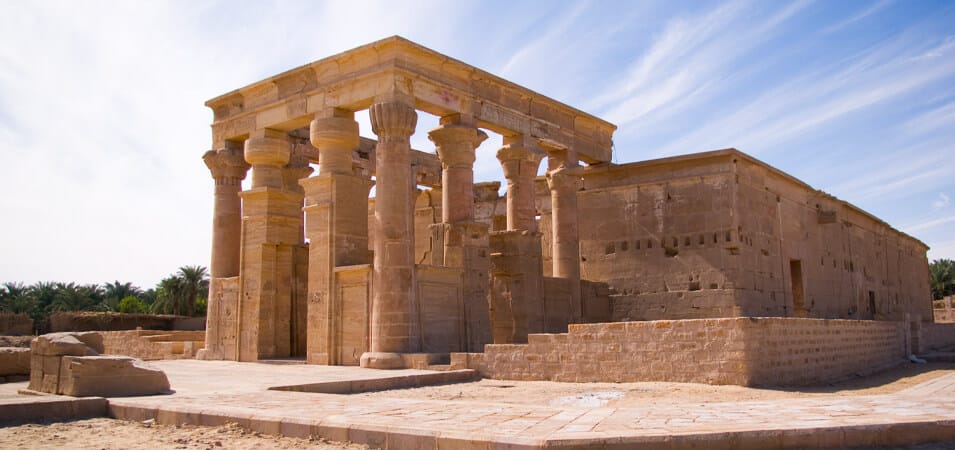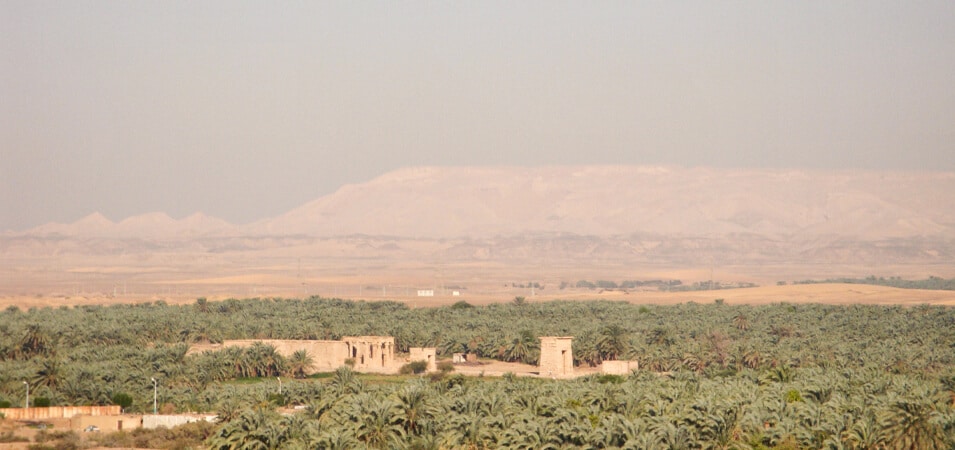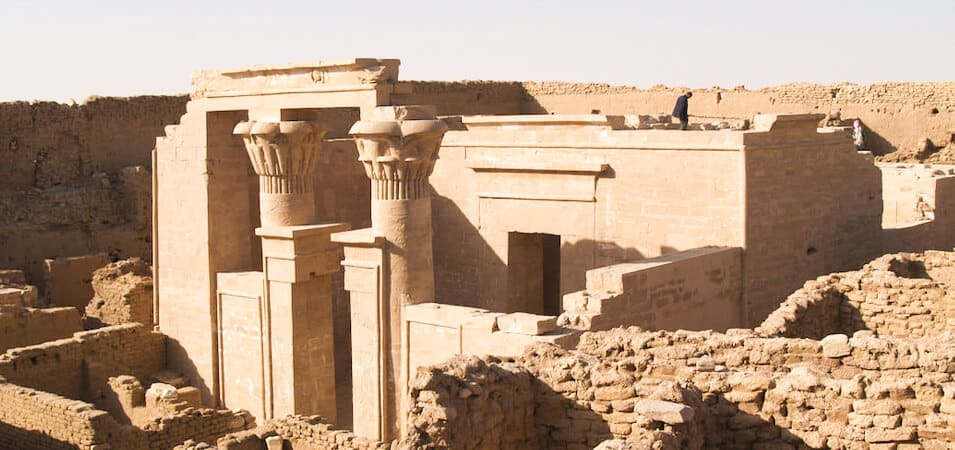Nestled in the heart of the Western Desert of Egypt, Kharga Oasis awaits intrepid visitors with its ancient wonders and natural beauty. This hidden oasis, the largest in Egypt, offers a haven of peace and a rich cultural history away from the hustle and bustle of the city. In this article, we will explore the historical importance, unique geography, and cultural heritage of Kharga Oasis.
Historical Importance
Kharga Oasis holds immense historical importance due to its strategic location between Egypt and the Western Desert. Civilizations have risen and fallen throughout the ages in this region, leaving behind a rich cultural heritage.
Don’t Miss To Check Out OurEgypt Tour Packages
Prehistoric Settlements in the Region

Before recorded history, early human civilizations settled in the Kharga Oasis region. Archaeological evidence reveals the presence of prehistoric communities that relied on the oasis’s fertile land and natural resources for survival. These ancient settlements provide a fascinating glimpse into the origins of human habitation in the area.
Ancient Egyptian Presence
1. Pharaonic Period
Kharga Oasis became an essential outpost for Egyptian civilization during the Pharaonic period. As a gateway to the Western Desert, it facilitated trade routes between Egypt and neighboring regions. The strategic value of the oasis was recognized by the Pharaohs, who left their mark through various architectural structures and inscriptions.
2. Role in Trade Routes
Kharga Oasis flourished as a vibrant trade hub, connecting ancient Egypt to distant lands. Caravans carrying precious goods, such as spices, incense, and gold, traversed the oasis, enriching the local economy and fostering cultural exchange. This crossroads of civilizations influenced the development of Kharga Oasis and shaped its history.
Roman and Byzantine Eras
1. Cultural Influences
The Roman and Byzantine eras brought significant cultural influences to Kharga Oasis. Roman armies stationed in the area constructed fortresses, leaving a lasting legacy of their presence. Byzantine Christianity also took root, as evidenced by the great religious sites and artifacts discovered within the oasis.
2. Architectural Remains
Remnants of Roman and Byzantine architecture dot the landscape of Kharga Oasis. Magnificent temples, churches, and monasteries stand as testaments to the vibrant past of the oasis. Intricate carvings, mosaics, and frescoes showcase the artistic prowess of these ancient civilizations.
Islamic and Modern Developments

With the Arab conquest, Islam spread across Egypt, including Kharga Oasis. Islamic rule brought further development to the oasis by constructing mosques and integrating Islamic traditions into the local culture. The influence of Islamic architecture and practices can still be witnessed today.
Unique Geography
Kharga Oasis stands out due to its unique geography and breathtaking landscapes. Dunes and limestone cliffs provide a stunning backdrop to this oasis in the desert.
Location and Topography
Situated approximately 600 kilometers south of Cairo, Kharga Oasis occupies a strategic position within the Western Desert. Surrounded by vast expanses of sand, the oasis is nestled between rocky hills and ancient dunes. Its geographic location makes it an ideal gateway for exploring the wonders of the Western Desert.
Oasis Ecosystem
1. Vegetation and Wildlife
Despite the arid environment, Kharga Oasis supports a surprising array of flora and fauna. Towering date palms, acacia trees, and olive groves dot the landscape, providing shade and sustenance. Wildlife, such as desert foxes, Egyptian vultures, and reptiles, have adapted to thrive
in this harsh yet fragile ecosystem.
2. Water Sources and Irrigation Systems
Natural springs and underground water sources sustain life within Kharga Oasis. Ancient and modern irrigation systems, including qanats and wells, ensure the cultivation of crops and the nourishment of the oasis. These innovative water management techniques have been honed over centuries.
Climate Patterns
Kharga Oasis experiences a desert climate with distinct temperature variations throughout the year. Summers can be scorching, with temperatures exceeding 40 degrees Celsius (104 degrees Fahrenheit), while winters bring cooler temperatures, occasionally dropping below freezing at night. Spring and autumn offer milder and more pleasant weather for exploration.
Cultural Heritage and Attractions

Kharga Oasis is a treasure trove of cultural heritage and attractions, offering visitors a chance to immerse themselves in the oasis’s rich history.
Qasr el-Ghueita
1. History and Architecture
Qasr el-Ghueita, a fortified mud-brick structure dating back to the Roman period, is a magnificent architectural gem within Kharga Oasis. It served as a residence for local rulers and offered protection against potential threats. The well-preserved design and ornate decorations glimpse the oasis’s historical grandeur.
2. Artifacts and Exhibits
Within the walls of Qasr el-Ghueita, a treasure trove of artifacts and exhibits showcases the rich cultural heritage of the oasis. Intricate pottery, exquisite jewelry, and ancient inscriptions offer insights into the lives of the oasis’s past inhabitants. Exploring the halls of Qasr el-Ghueita is like stepping back in time.
Al-Bagawat Necropolis
1. Ancient Christian Cemetery
Al-Bagawat Necropolis is a sacred site that holds the remains of early Christian communities in Kharga Oasis. Dating back to the 4th century, this ancient cemetery is one of Egypt’s oldest and best-preserved Christian burial grounds. It serves as a testament to the early spread of Christianity in the region.
2. Frescoes and Tombs
The walls of the tombs in Al-Bagawat Necropolis are adorned with breathtaking frescoes depicting biblical scenes and the lives of the early Christians. These colorful artworks provide a glimpse into the oasis’s early Christian inhabitants’ spiritual beliefs and artistic skills. Each tomb tells a story waiting to be discovered.
Temple of Hibis
1. Ancient Egyptian Temple
The Temple of Hibis, a marvel of ancient Egyptian architecture, stands in Kharga Oasis. Dedicated to the god Amun, it was constructed during the 26th Dynasty and served as a testament to the enduring religious traditions of ancient Egypt. Intricate carvings and hieroglyphs adorn the walls, depicting scenes of pharaonic glory.
2. Religious Significance
The Temple of Hibis holds immense religious significance, symbolizing the spiritual connection between the oasis and the gods worshipped by ancient Egyptians. It served as a place of devotion, offering prayers and ceremonies to ensure prosperity and protection for the oasis and its inhabitants.
Modern Cultural Festivals and Events
The annual Kharga Oasis Festival celebrates the oasis’s cultural heritage. Locals and visitors come together to showcase traditional music, dance performances, and handicrafts. The festival is a vibrant cultural exchange and appreciation platform, highlighting the oasis’s unique identity.
Tourism in Kharga Oasis

Kharga Oasis offers various options for travelers to access and explore its wonders.
Accessibility and Transportation Options
Kharga Oasis is reachable through various transportation options. Travelers can opt for domestic flights from Cairo to Kharga Airport or enjoy a scenic road trip through the desert. Buses and private car rentals are available for convenient travel within the oasis.
Accommodation and Lodging Facilities
Kharga Oasis offers a range of accommodation
options to suit every traveler’s preferences. There is something for everyone, from luxury resorts to cozy guesthouses and desert camps. Immerse yourself in the tranquility of the oasis by choosing a lodging facility that complements your desired experience.
Popular Tourist Activities
Desert Safari and Camel Trekking
Embark on a thrilling desert safari to explore the mesmerizing dunes and rugged landscapes surrounding Kharga Oasis. Traverse the sands on a camel’s back, immersing yourself in the timeless allure of the desert. Engage in exhilarating adventures and witness breathtaking sunsets that paint the sky in vivid hues.
Frequently Asked Questions

What Is the Best Time to Visit Kharga Oasis?
The best time to visit Kharga Oasis is during the spring (March to May) and autumn (September to November) seasons when the weather is mild and pleasant. It is advisable to avoid the scorching summer months, as temperatures can be extreme.
Are there any safety concerns for tourists?
Kharga Oasis is generally a safe destination for tourists. However, it’s always advisable to exercise caution, adhere to local customs, and follow the guidance of experienced guides or tour operators.
Can I camp in the desert?
Camping in the desert is a popular option for adventurous travellers. Several campsites and organized desert camping experiences are available, allowing you to immerse yourself in the tranquillity of the desert under the starlit sky.
Conclusion
History, culture, and nature intertwine in Kharga Oasis, creating a truly captivating destination. The oasis’s past is impressive, from ancient Egyptian temples to Roman ruins. Its distinct geology and prosperous environment makes it a desert oasis.
Kharga Oasis beckons adventurers to explore its hidden marvels and experience the harmonious blend of tranquillity and authenticity that defines this remarkable place. Let the serenity of the desert, the warmth of its people, and the allure of its heritage leave an indelible impact on your spirit. Uncover Egypt’s western boundary in Kharga Oasis.
Don’t Miss To Read Out Our Related Article:
